
Courgette: Sowing, Planting and Growing in the Vegetable Garden
Contents
The courgette in a nutshell
- Courgettes thrive in sunny spots, planted in rich, loose, deep and moist soil.
- They come in elongated or round shapes, with colours ranging from pale to dark green or vibrant yellow – the variety choice is vast and exciting!
- Sow seeds in April in pots indoors, or directly in the ground during May. Transplant seedlings to the garden after mid-May.
- Maintenance is child’s play – courgettes are easy to grow and highly productive. But keep an eye out for powdery mildew!
- Low in calories yet packed with minerals and vitamins, courgettes are wonderfully versatile in the kitchen.
Our expert's word
The courgette is a fruit-vegetable belonging to the large Cucurbitaceae family, which includes many other edible plants such as cucumbers, melons, squashes, etc. There is a wonderful diversity of courgette varieties. Among the most well-known are the ‘Verte de Milan’, a vigorous variety producing elongated, dark green fruits; the ‘Coucourzelle’ with its flavoursome fruits; the ‘Gold Rush’, which delights with its golden-yellow colour; and I mustn’t forget the ‘De Nice à fruits ronds’, perfect for stuffing. I do miss the necked varieties and “marrow” types, which are hard to come by these days!
Growing courgettes is very straightforward, even for beginner gardeners. They thrive best in full sun and in loose, organically rich soil, reasonably deep and which remains cool at the surface in summer. A summer mulch is highly recommended to maintain this moisture. It will also prevent the courgettes from having direct contact with the soil, which can lead to fruit rot.
Sowing courgettes is possible and recommended for all amateur gardeners. It’s economical and just as simple as growing courgettes overall. Sowing is preferably done in pots from April to obtain plants ready for planting out in the garden by May. It can also be done directly in the ground from May onwards.
If growing courgettes holds no secrets for you, why not try saving your own seeds? Discover all my tips at the end of this article! Undoubtedly fun, this practice contributes to your seed self-sufficiency and to sharing among gardeners – don’t hesitate for a second!
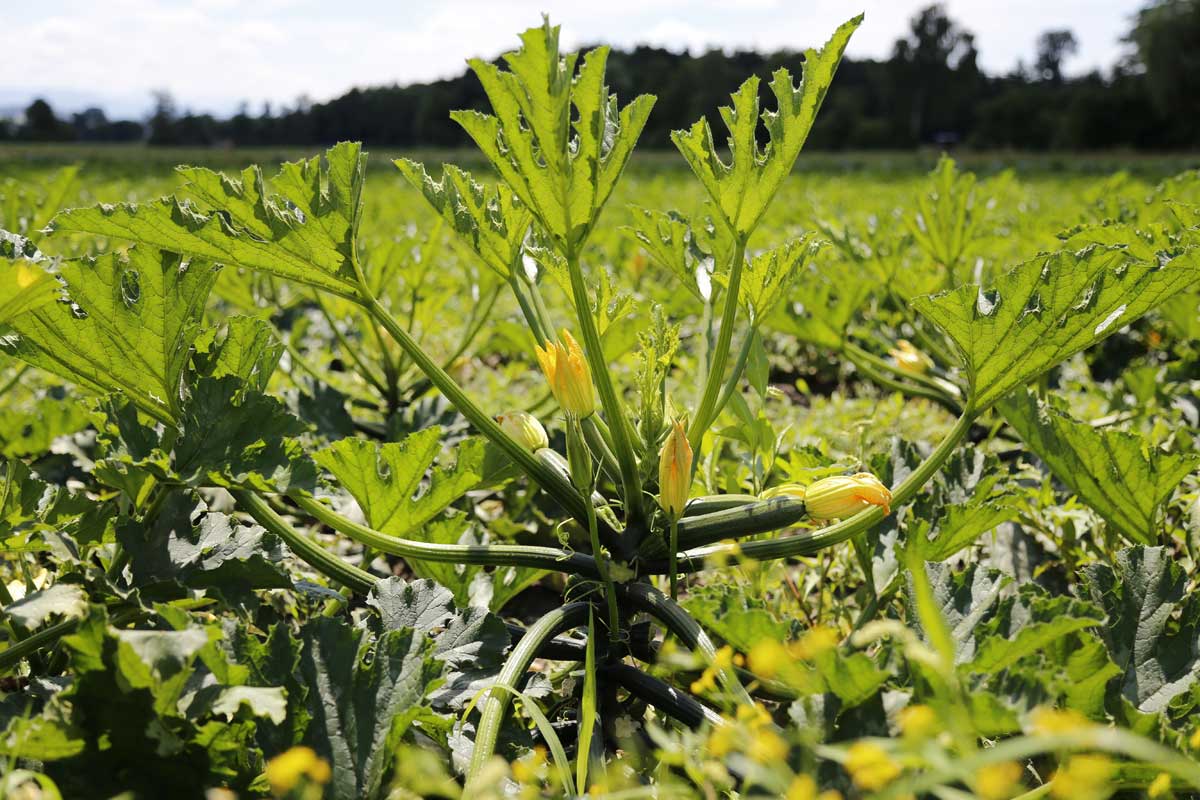
Field-grown courgettes
Description and botany
Botanical data
- Latin name Cucurbita pepo var. pepo
- Family Cucurbitaceae
- Common name Courgette
- Flowering Annual
- Height 4 to 6 years
- Exposure Full sun
- Soil type rich, loose, deep, moist in summer
- Hardiness 0°C
Like all plants in the Cucurbita genus, courgettes originate from the Americas, however the first cultivated courgette varieties only appeared in the 18th century in Italy. Unlike squashes, courgettes are eaten at a juvenile stage, before the skin hardens and before seeds form in the fruit. They are therefore harvested young, unripe.
The courgette – Cucurbita pepo var. pepo – is a fruit-vegetable from the Cucurbitaceae family, which includes many edible species cultivated by humans, such as squashes, melons, cucumbers and watermelons. The pepo species includes both courgettes as well as pattypan squashes, pumpkins and other oilseed squashes.
Courgettes, like most pepo, share certain common characteristics: they have a bushy growth habit, the leaves are distinctly lobed and prickly, as are the petioles and stems. Courgette flowering is monoecious, bearing both male flowers and female flowers on the same plant, at different locations. Female flowers bear fruit, male flowers produce pollen. Each flower blooms for just one day. Pollen is transported by pollinating insects like bees and bumblebees, making the pollination entomophilous. Additionally, courgettes are allogamous, meaning they favour cross-fertilisation with other varieties of the species or other plants of the same species.
A well-pollinated courgette flower will produce fruit with a shape characteristic of the variety – the most common form being elongated and straight, more or less ribbed. They can also be flattened at the ends and round in shape like the ‘Ronde de Nice’, with a neck or even club-shaped, like marrow types. Colours range from light green to dark green with varying marbling, to yellow and white. Courgette seeds are slightly convex and grey to white in colour.
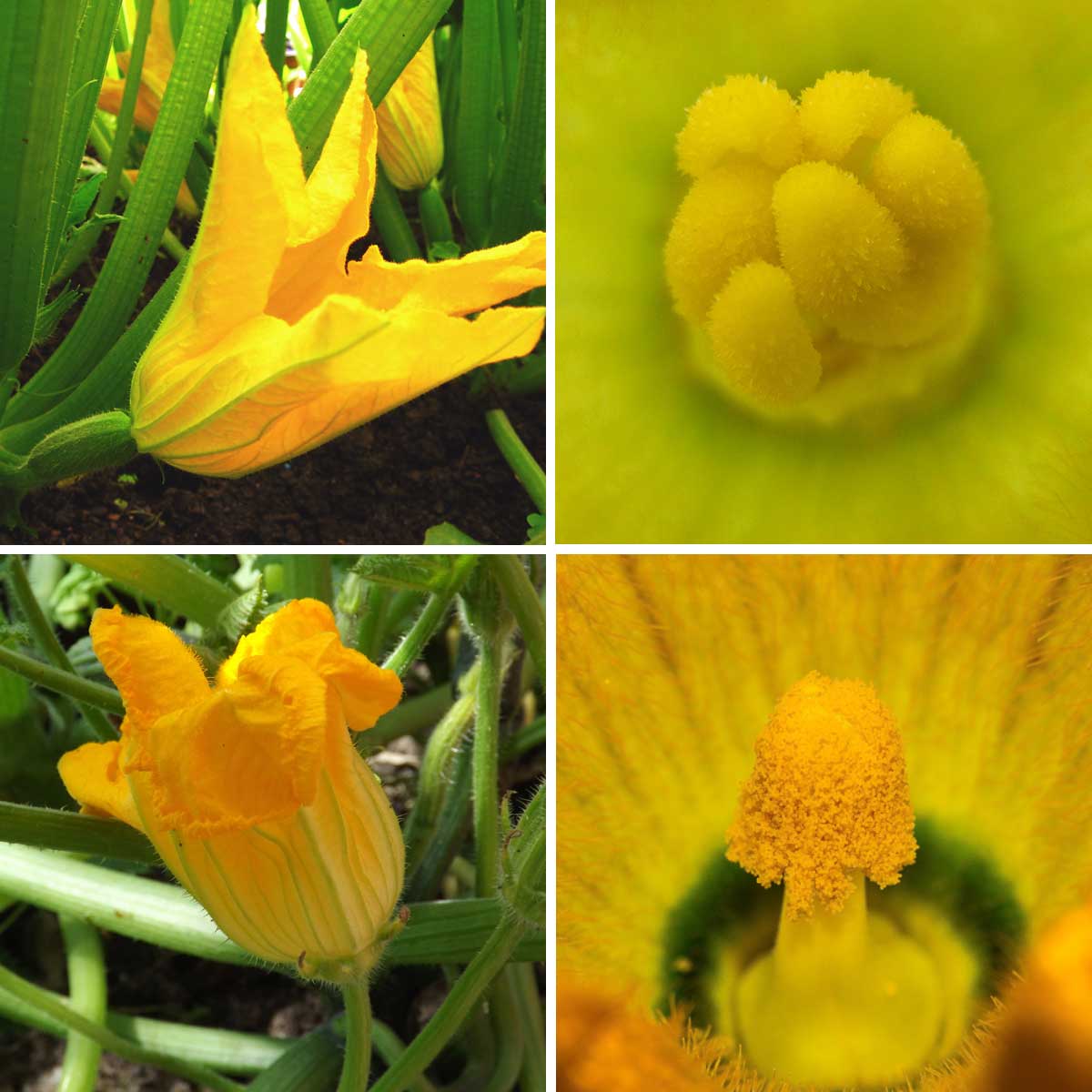
Top: Female flower in full view and close-up of the pistil stigma. Bottom: Male flower in full view, the peduncle is clearly visible and close-up of the stamen showing pollen grains.
Varieties of courgette
The choice of varieties focuses on their shape and culinary uses, colour, earliness, hardiness and of course flavour. Here is a selection of our reliable favourites!
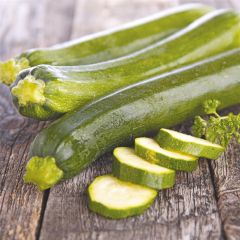
Courgette Alberello di Sarzana - Ferme de Sainte Marthe Seeds
- Flowering time June to August
- Height at maturity 50 cm

Non-trailing Zucchini - Vilmorin seeds - Cucurbita pepo
- Flowering time June to August
- Height at maturity 50 cm
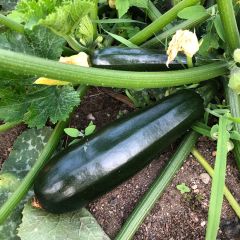
Zucchini Black Beauty - Cucurbita pepo
- Flowering time June to August
- Height at maturity 50 cm

Zucchini Grisette de Provence - Cucurbita pepo
- Flowering time August, September
- Height at maturity 50 cm

Courgette Genovese - Ferme de Sainte Marthe Seeds
- Flowering time June to August
- Height at maturity 50 cm

Courgette Verte Noire Maraîchère - Vilmorin Seeds
- Flowering time June to August
- Height at maturity 50 cm

Zucchini Firenze - Cucurbita pepo
- Flowering time June to August
- Height at maturity 45 cm
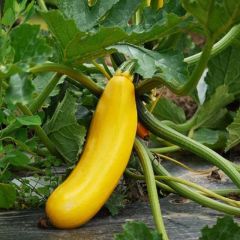
Yellow Courgette - Ferme de Sainte Marthe Seeds
- Flowering time June to August
- Height at maturity 50 cm

Courgette Nice à fruit rond - Vilmorin Seeds
- Flowering time June to August
- Height at maturity 50 cm
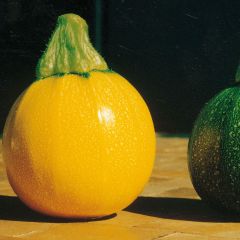
Zucchini Jaune One Ball - Cucurbita pepo
- Flowering time July to September
- Height at maturity 60 cm
Discover other Courgette seeds
View all →Available in 1 sizes
Available in 1 sizes
Available in 1 sizes
Available in 1 sizes
Available in 1 sizes
Available in 1 sizes
Available in 1 sizes
Available in 1 sizes
Available in 1 sizes
Sowing courgettes
Where and When to Sow Courgettes?
Courgettes are best sown in pots, though they can also be sown directly in the ground. Courgettes are hungry vegetables that thrive in soil rich in organic matter, loose and deep. Prepare the bed by adding compost at a rate of 3 to 4 kg per m2.
Courgettes can be sown:
- from mid-April to mid-May indoors or in a heated greenhouse
- from mid-May to mid-July directly in the ground.
How to Sow Courgettes?
You can either prepare seedlings to transplant into the vegetable patch once all risk of frost has passed or sow directly in place.
Preparing Seedlings:
- Fill pots or containers with good potting compost,
- Place two seeds per pot (flat) at a depth of about 2 cm and cover with compost,
- Water gently using a watering can.
Keep in a warm, bright spot (such as a windowsill) at around 20°C, keeping the compost moist but not waterlogged until germination, which usually takes 5 to 8 days. Once the seedlings are well developed, thin them out, keeping only the strongest plant.
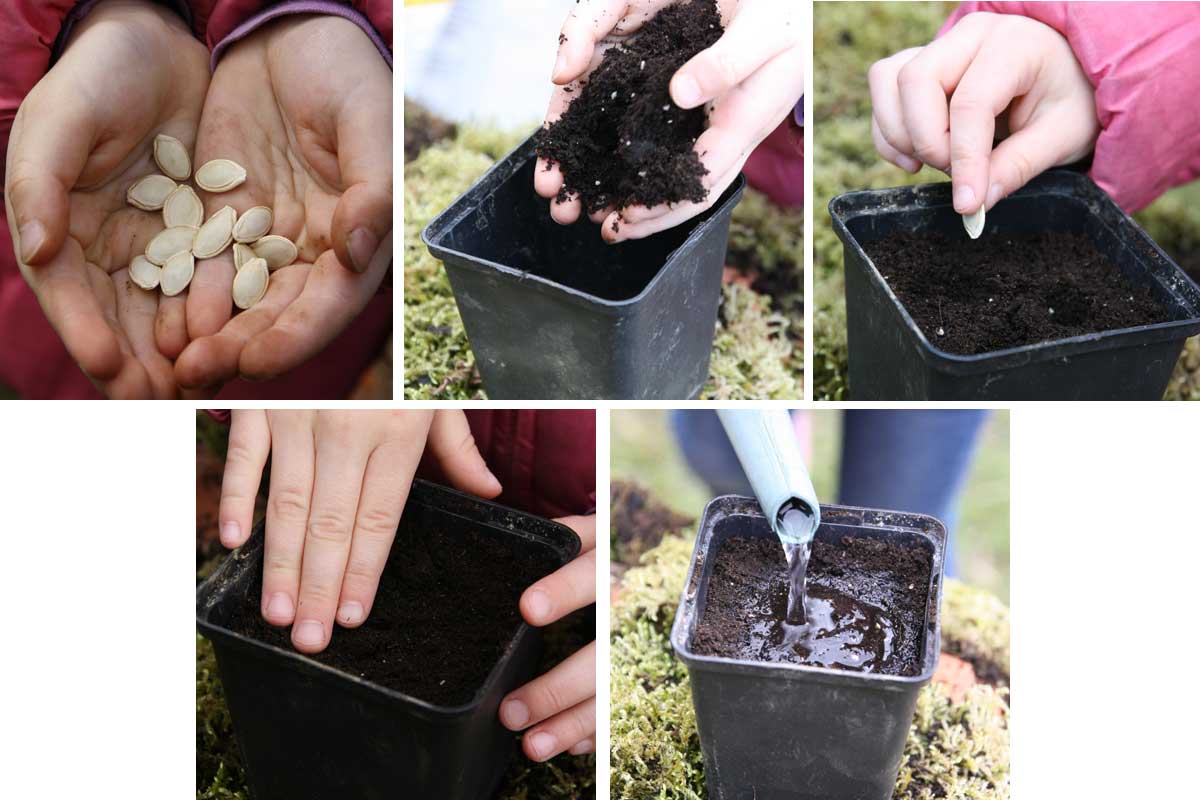
Sowing courgette seeds in pots
Direct Sowing in the Ground:
Sow in stations, in weed-free and loosened soil, spacing plants one metre apart in all directions:
- Dig holes 2 to 3 cm deep,
- Place three seeds per hole and cover with fine soil, then firm lightly,
- Water gently with a fine spray to avoid displacing the seeds,
- Keep the soil moist until germination.
After germination, when the seedlings are well developed, thin them out, keeping only the strongest plant per station.
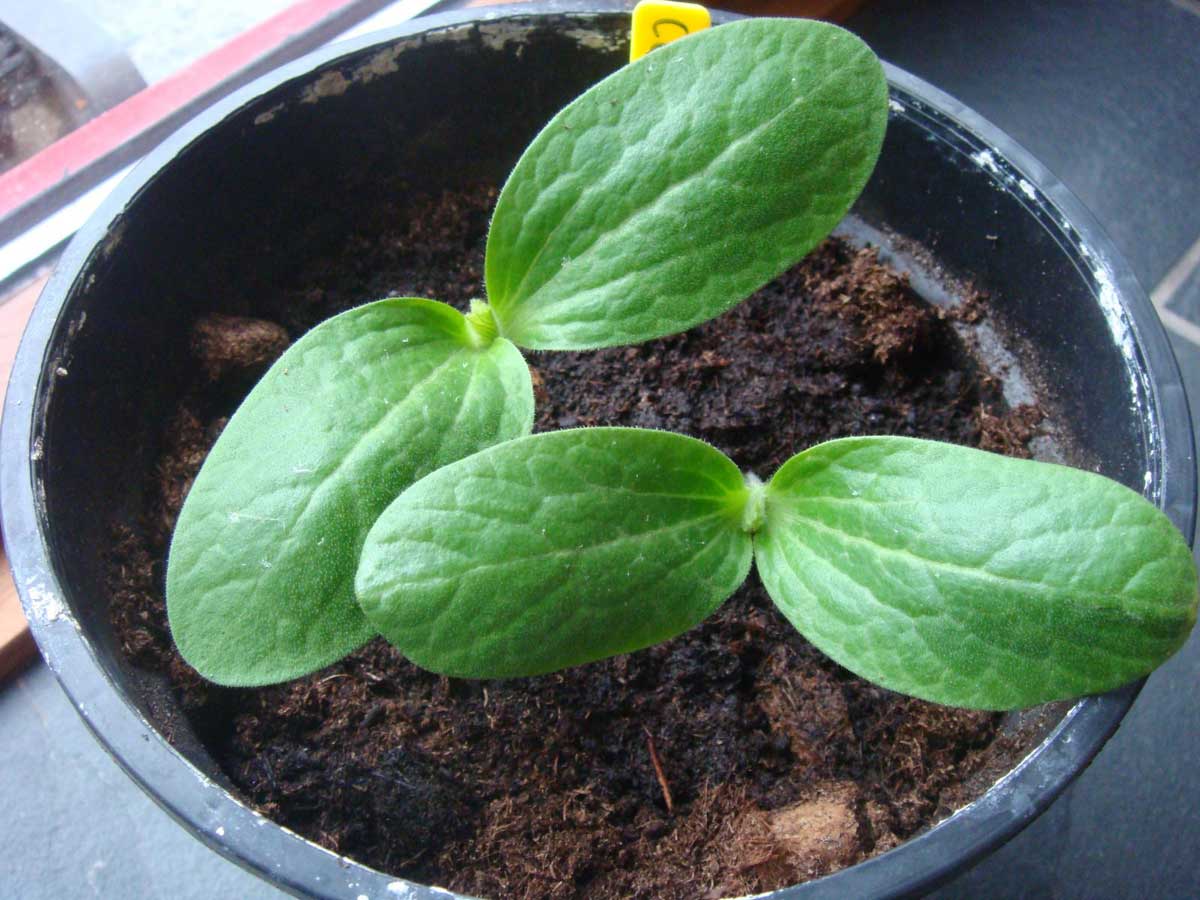
Young courgette seedlings. Thin out… or transplant!
Planting Courgettes: When and How
When to Plant Courgettes?
Courgettes should be planted from May onwards, preferably after the Ice Saints in regions more prone to cold. In the South of France, they can be planted as early as mid-April, keeping an eye on the weather and protecting them from late frosts with fleece if necessary. Planting can continue until July.
Space plants 1 m apart with 1.3 m between rows. Note that these distances can be reduced depending on the variety: “trailing” types spread more than “bush” varieties.
How to Plant Courgettes?
Courgettes require well-manured soil, previously enriched with compost or well-rotted manure at 3 kg per m2.
To plant your courgettes:
- dig a hole matching the size of the root ball,
- place the root ball and cover with soil,
- firm down and water to keep the soil moist,
- water regularly at the base to help establishment.
→ Also discover our tips for growing courgettes in pots
Growing, watering and companion planting for courgettes
Three well-maintained courgette plants will provide regular harvests for a family of four. If your diet is predominantly vegetarian… or you’re particularly fond of courgettes, don’t hesitate to plant more!
Regarding cultivation, it’s good to know that:
- harvesting the fruits encourages new flowering.
- Placing a slate tile or roofing tile under the fruit to protect it is a handy tip if the soil tends to retain moisture.
- Courgettes appreciate cool soil in summer, so remember to mulch around the plants.
- Avoid watering the leaves or flowers—water at soil level using the spout of your watering can.
- Due to their vigorous growth, courgettes are much easier to grow on their own, though they can be planted near basil, onions, and beans.
→ Pascale explains why courgettes sometimes fail to produce.
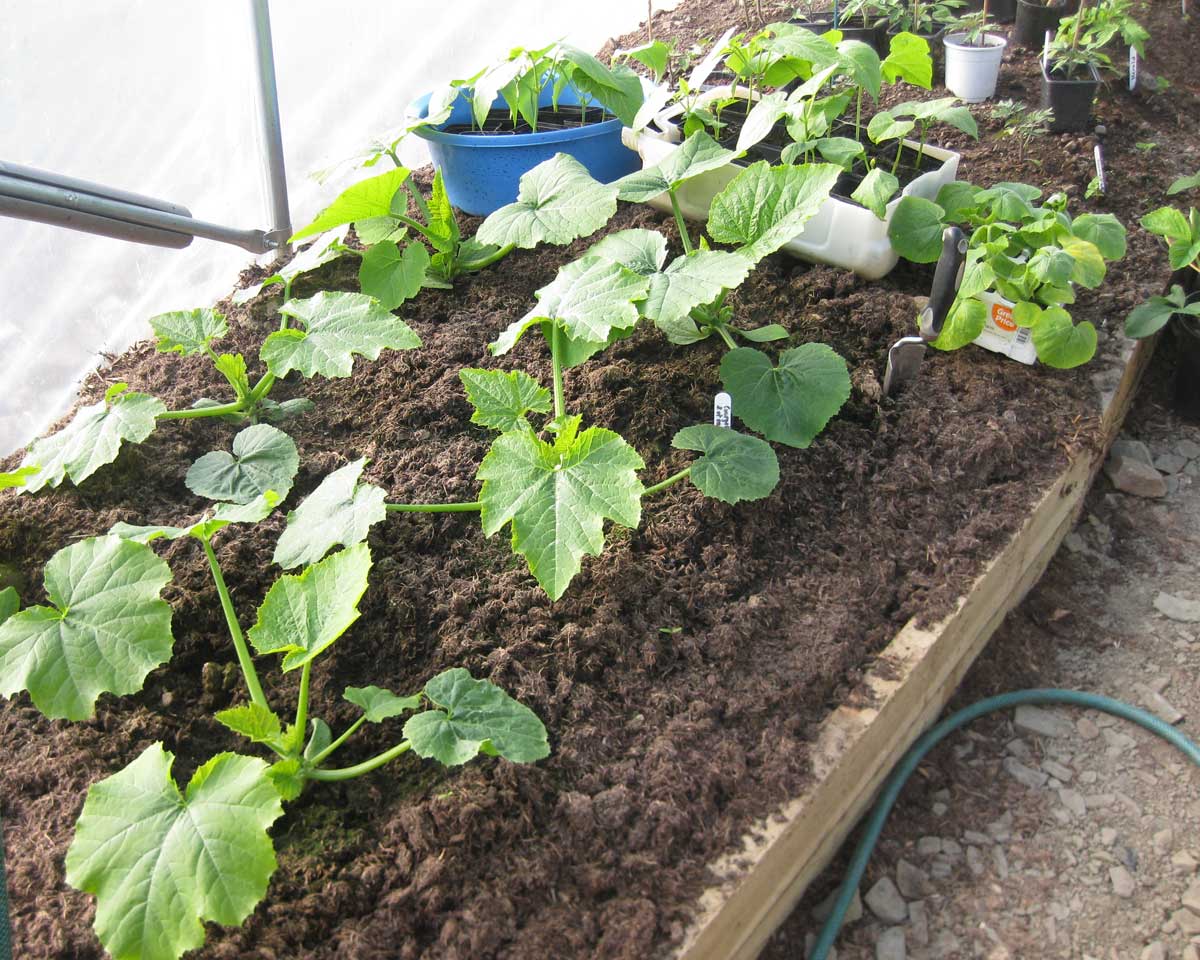
Growing courgettes in a greenhouse—ideal for an earlier seasonal harvest.
Common diseases
Powdery Mildew on Courgettes
Powdery mildew is a fungal disease (caused by a fungus) that appears as white, powdery spots on leaves, which eventually dry out, reducing yield and potentially killing the plant. This disease thrives in warm, humid conditions, with 27°C being the ideal temperature for fungal growth. Powdery mildew is common late in the season, so treatment is unnecessary at that stage. However, when plants are in full production, action should be taken. Here are some preventive and curative tips to follow:
- Space plants well when planting: 1 metre between each plant is advisable to allow good air circulation, helping leaves dry quickly after rain.
- Avoid nitrogen-rich fertilisers—opt for well-balanced compost instead!
- Keep a close eye on plants and remove early infections by cutting off affected leaves.
- A natural “magic potion” can be made with diluted skimmed milk (1 part milk to 10 parts water). Spray this solution onto affected leaves and repeat regularly to prevent the fungus from spreading.
- In biodynamic gardening, spraying horsetail decoction is a common method to inhibit fungal growth.
→ Read also: Diseases and Pests Affecting Squash and Courgettes
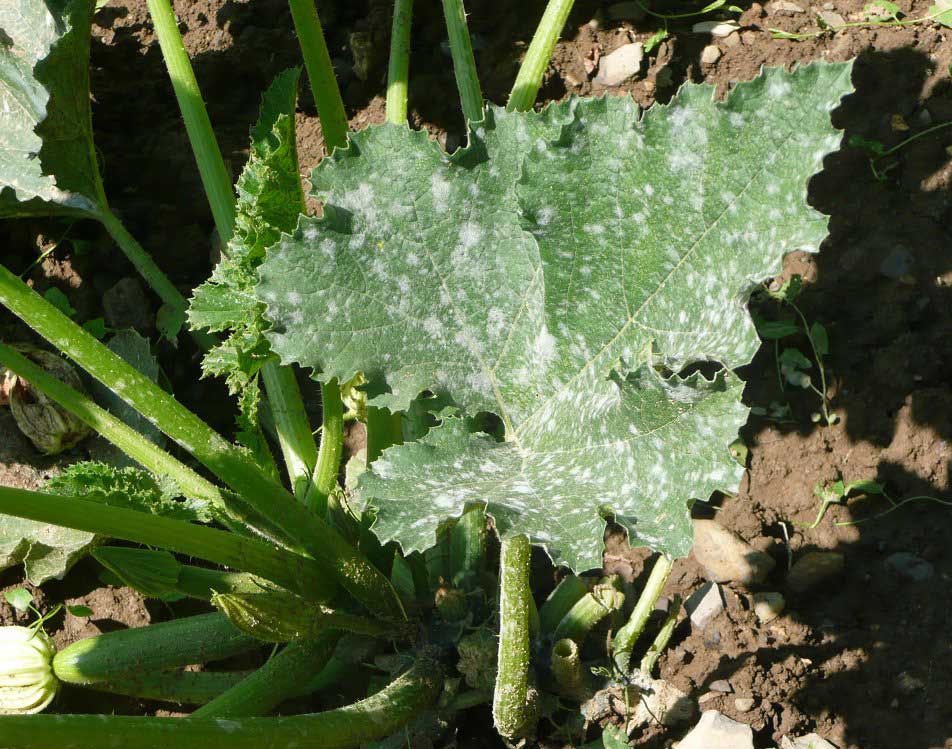
Powdery mildew on a courgette leaf. It is also visible on the petiole.
Harvesting and Storing Courgettes
Young courgettes are far more flavoursome and best eaten soon after harvesting, while still crisp. When harvesting, it’s preferable to cleanly cut the stem using a knife or secateurs rather than twisting the courgette off, as this tearing can invite disease.
Courgettes harvested later, perhaps after returning from holiday, can still be eaten but should first be hollowed out and peeled (the skin toughens). Their flavour, however, is far less appealing than young courgettes, though they remain useful for soups and ratatouilles.
Young courgettes keep for a few days in the fridge’s vegetable drawer. Older courgettes can be stored for several weeks. Courgettes also preserve well when chopped and frozen, or jarred and sterilised.
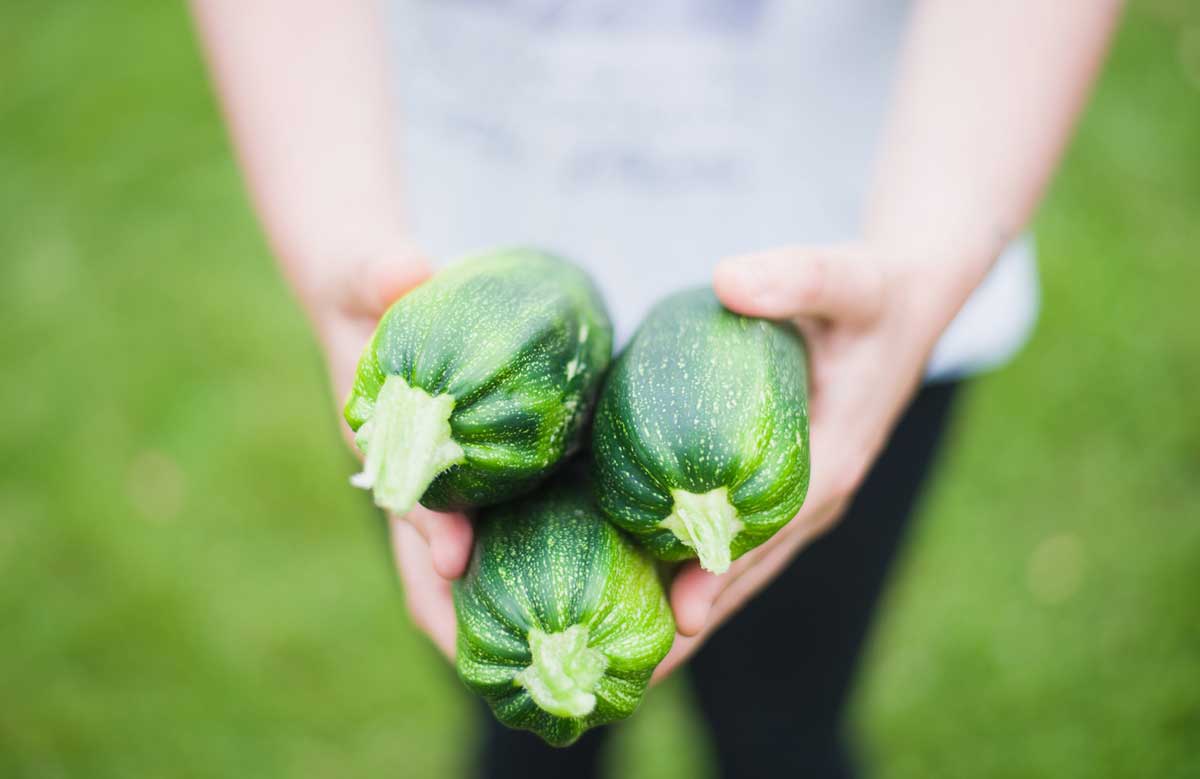
Harvesting courgettes
→ Also discover Ingrid’s advice on lacto-fermentation preservation
Uses and Nutritional Benefits
Courgettes can be used in a variety of dishes: grated raw, or cooked in ratatouille, stir-fries, tagliatelle, or of course stuffed – the round varieties or large hollowed-out courgettes are ideal for this purpose. Slightly less common, both male and female courgette flowers are edible and are typically stuffed or cooked as fritters. For the female flower, the pistil is removed, while the tiny courgette is left attached to the flower.
Discover how to make courgette flower fritters?
From a nutritional standpoint, courgettes are rich in minerals (potassium, magnesium, calcium) and vitamins, particularly provitamin A, and vitamins B and C. They also contain fibre and are very low in calories, making them an excellent slimming vegetable.
Saving Your Own Courgette Seeds
As we’ve seen previously, the courgette is entomophilous and allogamous, favouring cross-fertilisation with other varieties of the species or other plants of the same species, with this pollination occurring through the action of pollinating insects. Hand pollination is therefore recommended to ensure the desired variety’s characteristics are preserved.
Hand Pollination of Courgettes
It is first recommended to grow several plants of the same variety, at least six plants. Select the finest plants that match the variety’s description, with good early vigour, to keep and use for seed production.
- The day before pollination, identify the female flowers to be pollinated and the male flowers that will provide the pollen – at this stage, their corollas are cream-coloured. If unsure, observe the flowers’ development over several days to pinpoint the stage just before they open. Remember, courgette flowers only open for a single day!
- Using clothes pegs, tie off the male and female flowers to prevent them from opening and to stop insects from pollinating them.
- The following morning, pick the tied male flowers from one plant to pollinate another plant of the same variety.
- Cut the corolla of the male flower to expose the pollen-bearing stamens.
- Remove the peg from the female flower and gently open the corolla.
- Carefully spread pollen from two to three male flowers onto the stigma (pistil) of the female flower.
- Re-tie the corolla of the female flower with a clothes peg.
- Clearly mark the pollinated flowers, for example with stakes.
Pollinated courgettes should be harvested when fully mature, meaning when the stem dries out and the skin changes colour and hardens. Once picked, the courgettes should be stored for a month before extracting the seeds. To separate them from the flesh, soak them in water and allow them to dry thoroughly in a warm, well-ventilated area for several days before bagging.
Learn more about hand-pollinating courgette flowers
Useful resources
- Discover our wide range of courgette seeds, both conventional and organic!
- Find Ingrid’s advice in this article on sowing and growing squashes and courgettes, and discover her favourite varieties!
- Explore our selection of top courgette varieties: the reliable choices.
- Learn more about hand-pollinating courgette flowers
- Discover the best companion plants for courgettes in the vegetable garden
Frequently asked questions
-
Why are my courgettes only producing flowers and no fruit?
The most likely cause of a zucchini rotting is often that it hasn't been pollinated. The young zucchini turns yellow and then falls off the plant. - To remedy this in the long term, welcome biodiversity into your garden! - In the short term, pollinate your zucchinis yourself in the same way as explained above for seed production, being less strict about variety selection—you can even crossbreed different Cucurbitaceae species.
-
Why Are My Courgettes Rotting on the Plant?
A courgette in direct contact with soil that retains too much moisture (clay-heavy), during prolonged rainy spells late in the season, often rots while still on the plant.
While we can't control the weather, you can place a slate tile beneath developing fruits or grow your plants on landscape fabric if this is a recurring issue in your vegetable garden.
- Subscribe!
- Contents



































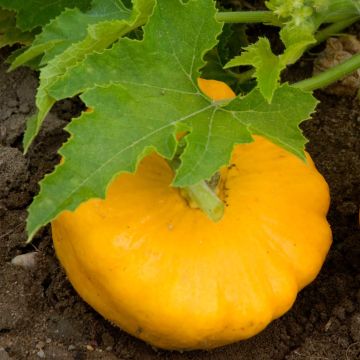
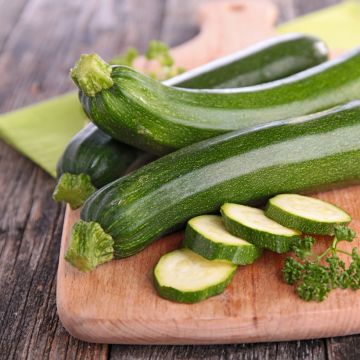
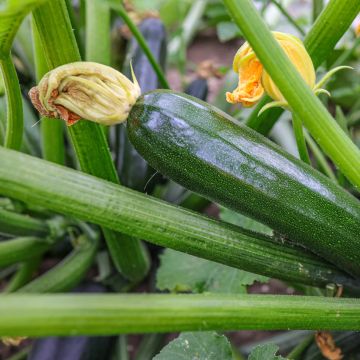
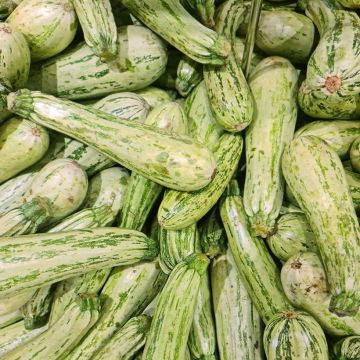

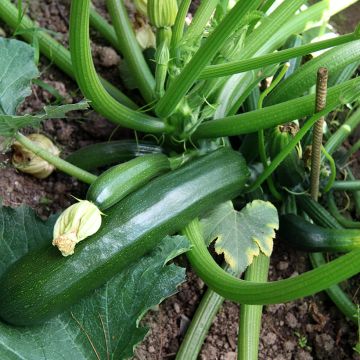
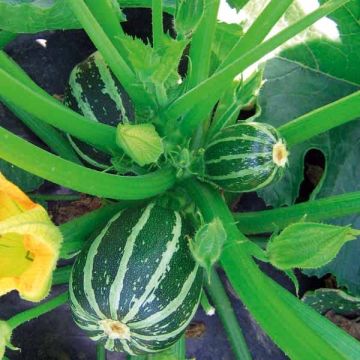
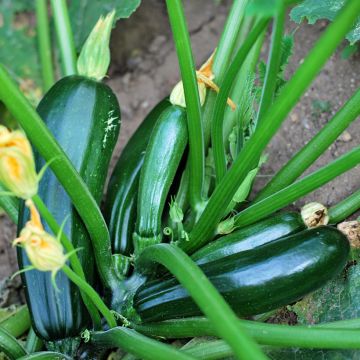
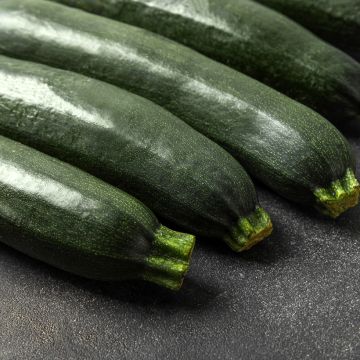
Comments